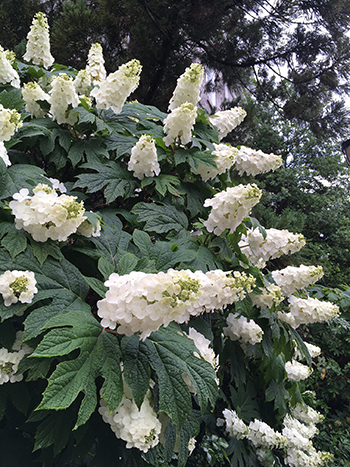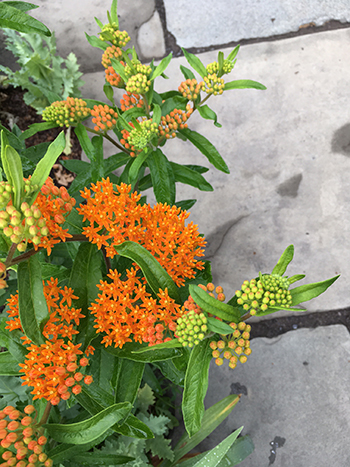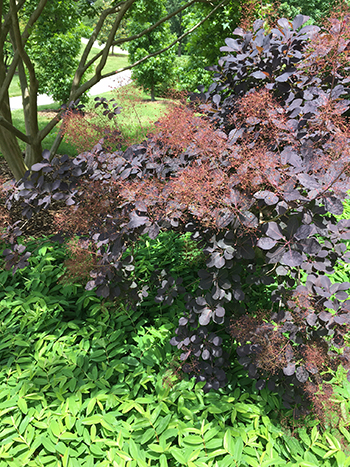
Plants of the Week: June 7
Guest Author: Summer Intern Julia Hackstie

Hydrangea season is here, and one of our southeastern U.S. native oakleaf hydrangeas, Hydrangea quercifolia ‘Snow Queen’, is starting to bloom on the northeast corner of Parrish Hall. The white flowers open along the cone-shaped panicles in succession from the bottom to the top. The ‘Snow Queen’ cultivar differs from the species in that the flower panicles are larger, more numerous and sit slightly more erect on the branch tips. Flowers eventually turn a pink-purple as the season progresses, and the leaves provide beautiful fall color in varying shades of maroon.
I find this shrub especially interesting on snowy, winter days with its exfoliating bark and dried blooms that persist at the ends of the branches. I would recommend this shrub along foundations or near patios where there is part sun – preferably where there is some afternoon shade and moist, well-drained soil. It does well as an understory plant, brightening shadier areas. It also provides ecological services by providing cover to wildlife, bees and butterflies are attracted to the flowers and songbirds will eat the seeds. Photo credit: J. Hackstie

In the Scott Entrance Garden along the sidewalk adjacent to the Cunningham House, Asclepias tuberosa (butterfly weed), a native perennial, is starting to bloom. It is ready to greet arriving Monarch butterflies completing their migration from their overwintering grounds in Mexico. Brilliant orange flowers last throughout the summer months, providing pollinators with essential nectar. In late summer, seed pods form and later open to disperse the silky follicle-like seeds that are carried by the wind. It prefers full sun and sharply drained soils, perfect for the edge of a driveway or walkway.
Asclepias tuberosa is one of our native milkweed plants that hosts Monarch butterfly larvae. The female Monarch lays her eggs on the milkweed and after hatching, the caterpillars feed on the foliage until they are ready to pupate. Planting this low maintenance perennial helps to support the lifecycle of the Monarch butterfly whose populations are currently in peril due to loss of habitat, pesticide use, and climate change. According to the Xerces Society, an annual survey conducted in the winter of 2020-2021 revealed a decline of overwintering populations in central Mexico of 26% as compared to the previous winter. Please consider adding Asclpeias tuberosa to your garden this summer along with other nectar-rich plants to support our pollinator populations, and your efforts will go a long way. Photo credit: J. Hackstie

The Cotinus coggygria ‘Purple Supreme’ (common smokebush) is currently a stand-out in the Summer Bloom Border by Old Tarble. Once the small, insignificant flowers fade on the terminal flower panicles, tiny pink hairs form on the inflorescences which gives the plant an appearance of being covered in clouds of smoke. The airy plumes last well into the summer, and are especially beautiful when backlit by the morning or late afternoon sun, giving an ethereal effect. Branches seem to sway in unison in the summer breeze, as if putting on a dance. The deep purple, oval leaves of this multi-stem deciduous shrub will persist all summer, eventually turning a vibrant scarlet red in the fall.
Cotinus coggygria ‘Purple Supreme’ is the perfect size to be used as a single specimen in the garden, or it can be used to create a privacy screen when used in multiples. This shrub can grow to an average of 10 feet high and wide, does best in full sun and well-drained soil, and is generally disease and pest resistant. To prevent the plant from getting too leggy, selective branches can be pruned back in early spring; however, if cut back too hard the regrowth will potentially not flower that year. Cutting it back close to the ground will, however, serve to rejuvenate the plant. All in all, this is an exceptionally tough, hardy plant worthy of a permanent place in your home garden for summer and fall interest. My choice would be to use this as a backdrop to contrast with pastel-hued blooming perennials or foliage plants in chartreuse or silvery blue-green color schemes. Photo credit: J. Hackstie





Jill Windsor
Posted at 12:11h, 21 JuneSo interesting to read. Fantastic job Julie!
JILL WINDSOR
Judy Erickson
Posted at 14:17h, 21 JuneThis is so exciting Julie. Your Mom had told us of your keen interest in Agriculture. I wish you well with your internship!